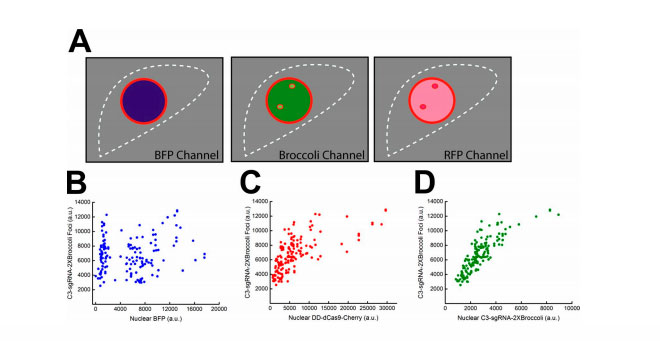A study published in the Journal of Cell Biology by scientists at UMass Medical School reveals important new details about the inner workings of the CRISPR/Cas9 machinery in live cells that may have implications for the development of therapeutics that use the powerful gene editing tool.
“We don’t know a lot about the details of how the CRISPR/Cas9 complex gets around the genome of a live cell and finds its target,” said Thoru Pederson, PhD, the Vitold Arnett Professor of Cell Biology and professor of biochemistry & molecular pharmacology. “What we’ve learned in this study about how this machinery works is important and useful for gene editors looking to develop tools for the lab and potentially the clinic.”
A component of the bacterial immune system that protects it from viral invasion, the CRISPR/Cas9 complex is a powerful gene editing system. More efficient and precise than previous technologies, the CRISPR/Cas9 complex is being adapted in the lab, as scientists find ways to program and deliver it quickly to selectively edit specific genetic sequences for study. In order to cut a piece of double-stranded DNA, CRISPR/Cas9 makes use of a guide RNA made of roughly 20 nucleotides to target specific regions of a genome at which the Cas9 complex then makes the cut. This allows scientists to remove or insert genetic sequences into the genome.
Because the underlying dynamics of how the CRISPR/Cas9 system works inside live cells aren’t well understood, some delivery systems and techniques have been more successful than others. In order to observe the actions of the CRISPR/Cas9 system at work in a live cell, Dr. Pederson and colleagues developed a technique for labeling the guide RNA and Cas9 elements with different florescent molecules so they could be tracked simultaneously. The research team included Hanhui Ma, PhD, research specialist in the Pederson laboratory and co-first author of the Journal of Cell Biology article; David Grunwald, PhD, assistant professor of the RNA Therapeutics Institute; and Li-Chun Tu, PhD, postdoctoral fellow in the Grunwald lab.
What they found is that the guide RNA, when not bound to Cas9, is extremely short-lived. When the Cas9 and guide RNA do assemble, the complex is much more stable, with about half showing a lifetime in the cell nucleus of approximately 15 minutes and the remainder being considerably more stable.
“Cas9 stabilizes the guide RNA,” said Dr. Ma. “If you’re delivering the guide RNA and Cas9 separately into the cell for them to then assemble it won’t be as efficient because some of the guide RNA will degrade. If you deliver them both into the cell, already assembled, you’ll see more activity.”
The other observation the team made was that the duration of target residence by the Cas9-guide RNA complex determines whether the DNA will be cut. When the guide RNA sequence perfectly matched the target DNA sequence, the Cas9-guide RNA complex remained bound for as long as two hours before leaving, with cleavage completed. With mismatched guide RNA-target DNA sequences, the complex lingered for as little as a few minutes and cleavage was impaired.
Knowing this, scientists can potentially predict mathematically where an off-target cut may happen based on how long the CRISPR complex sits on the genome, said Ma.
“We still don’t know the rules of CRISPR,” said Ma. “Everybody wants to know what will happen when it’s delivered into a live cell. This study helps write a piece of that operating manual.”
